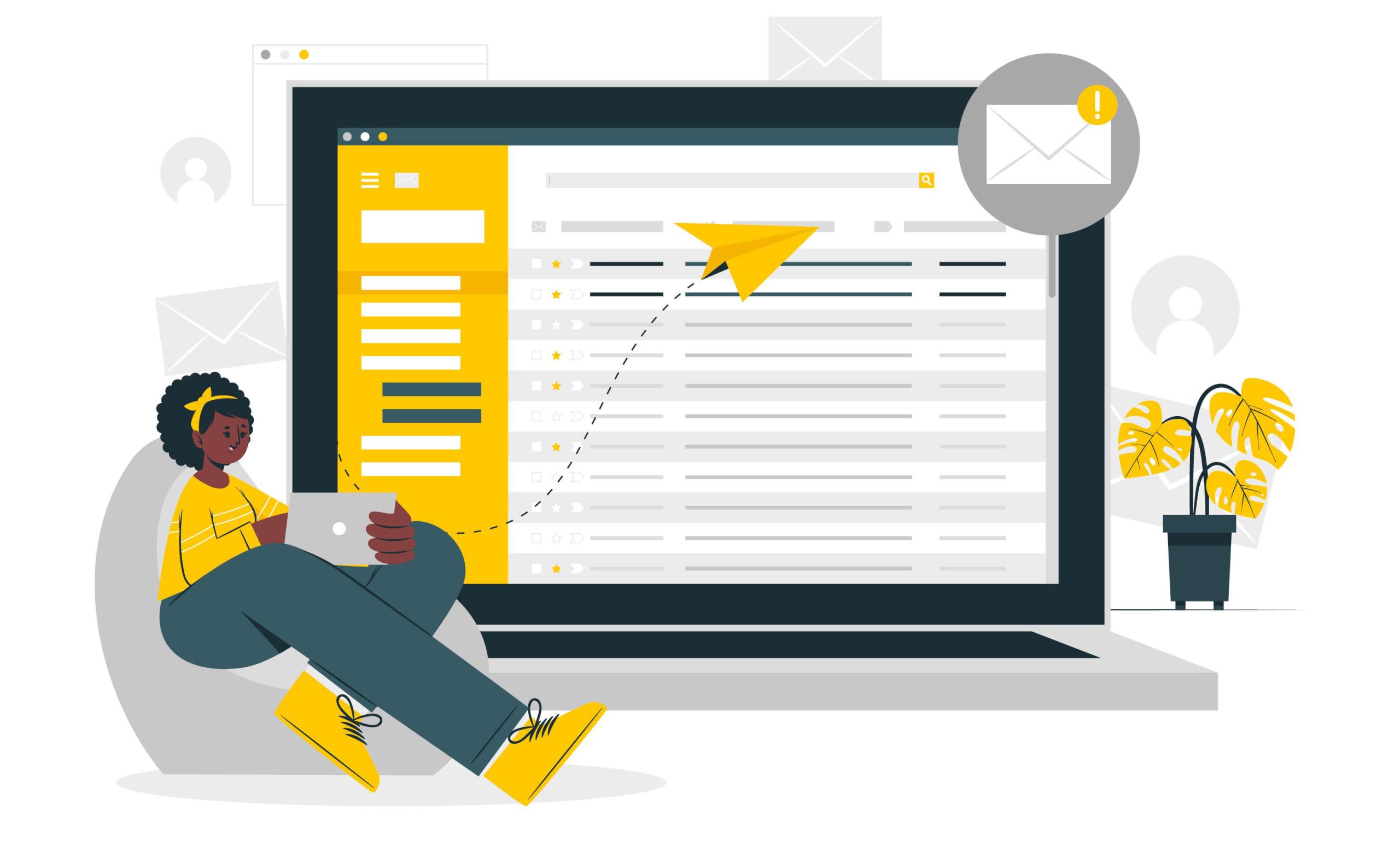Email marketing for lawyers offers a potent means of maintaining relationships with current and potential clients without coming across as obtrusive or too promotional. Your ability to remain in the forefront of people’s minds can directly impact referrals, repeat business, and the frequency with which someone thinks of you when they need legal assistance, regardless of whether you work as a solo practitioner or for a large company.
However, email marketing for attorneys isn’t about using gaudy layouts or pushy sales techniques. It all comes down to regularly providing value, enlightening your audience, and arriving in their inbox at the appropriate moment with the appropriate message. When done correctly, email keeps your business current, gradually increases confidence, and eventually results in more consultations and clients that stay with you.
Why Email Marketing Works for Law Firms

People don’t need a lawyer every week; thus, legal services aren’t like regular purchases. Maintaining your relevance in between legal emergencies is key for this reason. You can do just that using email marketing, which keeps your business in front of prospective customers in a valuable and non-intrusive manner.
Here’s why it works:
1. You Stay Top-of-Mind
Consistent, beneficial communications increase the likelihood that someone will think of you when they need legal assistance, even if they don’t need it today. Regularly checking their mailbox fosters familiarity and trust, regardless of how long it will be—six weeks or six months.
2. You Build Authority and Credibility
You can establish your company as an authority by providing educational content such as “What to do after a car accident” or “3 things every small business should include in their contracts.” It demonstrates your understanding of your customers’ issues and your commitment to providing them with more than simply a sale.
3. You Convert Passive Readers into Clients
Before contacting you, some potential customers wait months on your email list. Consistent communication gives customers the knowledge and assurance they require to select your company when appropriate.
4. You Get More from Past Clients
Additionally, email promotes repeat business and referrals. A buddy who recently had a car accident may need estate planning, or a client you assisted with a divorce may need it later. Keeping in contact keeps those opportunities open.
What Types of Emails Should Lawyers Send?

Instead of hard-selling, the most successful legal email marketing emphasizes teaching. Clients prefer practical solutions, clarity, and peace of mind to legalese or incessant invitations to “book now.” Your legal practice may foster trust and remain relevant in people’s lives long before (and after) they require representation by providing timely, helpful information.
Here are a few email types lawyers should consider including in their strategy:
1. Educational Newsletters
Share tips related to your practice area, for example, “What to do if you’re in a car accident” or “How to protect your business from lawsuits.” Offer value without expecting an immediate return.
2. Client Success Stories or Case Highlights
(With permission or anonymized.) Share a short story showing how your firm helped someone achieve a positive outcome. These build trust and demonstrate results without sounding boastful.
3. Legal Updates & Changes in the Law
Keep your readers informed about new state regulations, deadlines, or policy changes that could affect them. This is especially helpful for business law, immigration, estate planning, or employment law.
4. Frequently Asked Questions (FAQs)
Turn common questions you get on consultations into short, informative emails. These build authority and answer what potential clients are already wondering.
5. “What to Do If…” Scenario Emails
These are practical, easy-to-read guides. Examples:
- “What to do if you’re served with divorce papers”
- “What to do if your insurance denies your injury claim”
6. Seasonal or Timely Reminders
Remind clients when it’s time to review their will, file business paperwork, or prepare for end-of-year financial moves. These are especially effective for estate planning and tax law practices.
Consistent, helpful email content keeps your firm at the top of the inbox—and top of mind when legal help is needed.
Writing Subject Lines That Get Opened
The first, and sometimes only, opportunity to attract attention is in your subject line. If an email gets lost in a packed inbox, even the most beneficial ones won’t be read. Creating clear, curiosity-driven, and emotionally relevant subject lines is essential for law firms looking to increase open rates and maintain audience engagement.
Here’s how to write subject lines that stand out (without sounding like clickbait):
1. Tap Into Fear or Urgency—Ethically
People are more likely to act when something feels time-sensitive or risky. In law, this can be done responsibly by addressing real consequences.
Examples:
- “5 Legal Mistakes That Can Cost You Everything”
- “Miss This Deadline? You Could Lose Your Case”
- “Is Your Business Protected from Employee Lawsuits?”
- “More People Are Being Wrongfully Accused of This Crime…”
2. Use Curiosity to Spark the Click
Ask a question or hint at a surprising fact that makes the reader want to know more.
Examples:
- “Do You Really Need a Will? Most People Don’t Know This”
- “This Contract Clause Could Ruin Your Deal”
- “What Happens If You Skip a Background Check?”
3. Be Direct with Value or Outcome
Let the subject line preview what the reader will learn or gain.
Examples:
- “How to Avoid a Costly Divorce Battle”
- “The Right Way to Handle a Car Accident Claim”
- “Your Guide to Suing a Landlord (And Winning)”
4. Keep It Short and Non-Legalese
Steer clear of long-winded wording or legalese. Address your audience in the same way as you would in a first consultation.
By experimenting with various subject line formats and monitoring open rates, you can rapidly determine what appeals to your audience. An effective subject line can distinguish between a new client request and an unread email.
Building a List the Right Way

Building a high-quality list of people who genuinely want to hear from your law practice is the first step in creating a successful email campaign. Instead of purchasing lists, which frequently results in subpar outcomes and legal problems, concentrate on expanding your list naturally by using individuals who are currently interacting with your business or content.
1. Use Gated Content to Offer Value Up Front
Create downloadable resources, like legal checklists, quick-start guides, or “What to Do If…” PDFs, and offer them in exchange for an email address.
Examples:
- “10 Questions to Ask Before You Sign a Business Lease”
- “The Ultimate Guide to Arizona Estate Planning”
- “What to Do After a Car Accident – Step-by-Step Checklist”
2. Capture Emails During Intake
Ask new inquiries or clients if they’d like to receive helpful legal updates, tips, or newsletters. Make this opt-in part of your intake or contact form.
3. Add Sign-Up Opportunities Across Your Website
Use exit-intent popups, blog post callouts, or sidebar forms inviting readers to subscribe to updates or download resources. Be clear about what they’ll get and how often.
4. Stay Compliant
Lawyers are held to a higher ethical standard. Make sure your email practices follow:
- CAN-SPAM regulations (unsubscribe link, clear sender info)
- State bar advertising rules (no false or misleading claims)
- Respect for client confidentiality—never share sensitive case info in email
With the right list-building strategy, your emails will reach people who already see value in what you have to offer and are more likely to convert when they need legal help.
Segmenting and Automating for Better Results

Making sure the appropriate individuals receive your emails at the right time is the next step after building your email list. This is where automation and segmentation, two of the most effective strategies for increasing engagement without adding hours to your workload, come in.
What is Segmentation?
Segmentation means dividing your list into smaller groups based on shared characteristics so you can send more relevant, personalized content.
For example, you might segment by:
- Practice area interest (family law, business law, personal injury)
- Stage of the client journey (lead, active client, former client)
- Location (especially if you serve multiple counties or regions)
- Past engagement (who’s opened or clicked recently)
Sending the same message to everyone rarely works. Segmented emails consistently see higher open rates, click-through rates, and conversions.
How to Use Automation as a Law Firm

Email automation lets you set up sequences that run on autopilot, nurturing leads and following up without manual effort.
Examples of effective automated sequences:
- Welcome email: Sent instantly when someone joins your list
- Lead nurture series: A 3–5 email series that shares FAQs, client reviews, and a consultation invite
- Follow-up after consultation: Reinforces your value and encourages next steps
- Reminder emails: For annual check-ins (estate planning), court dates, or legal deadlines
Why It Matters:
Automation guarantees that no lead is missed, saves time, and keeps your company responsive. Even when used in conjunction with segmentation, it gives your email marketing a more individualized feel.
Tracking Performance and Making Improvements

Understanding the effectiveness of emails is what elevates good marketing to great marketing; simply sending them is only half of the task. By monitoring important indicators, you may discover what your audience responds to, what needs work, and where your next greatest opportunities are.
Key Email Metrics for Law Firms:
- Open Rate: How many people opened your email (a good benchmark is 20–30%)
- Click-Through Rate (CTR): How many clicked a link in the email (aim for 2–5%)
- Unsubscribe Rate: A small number is normal—watch for sudden spikes
- Reply Rate: Valuable for relationship-based practices like estate planning or family law
- Conversion Rate: The percentage of recipients who took a desired action (booked a call, downloaded a guide, etc.)
A/B Testing Tips
Not sure which subject line or call-to-action (CTA) works better? Run A/B tests by sending different versions to small groups and using the winner for the rest of your list.
You can test:
- Subject lines
- Send times
- CTA button copy
- Email design/layout
- Content format (text vs. graphic-heavy)
Clean Your List Regularly
Remove inactive subscribers to improve deliverability and reduce costs. A clean list ensures your emails get delivered to those who want to hear from you.
Bonus Tip: Re-engagement campaigns can help win back cold contacts before you remove them completely.
By monitoring your email performance and optimizing based on data, your firm can improve engagement over time without increasing your workload or budget.
Build Trust First, Clients Will Follow
Building trust over time is the goal of email marketing, not pitching legal services in every communication. That trust is your greatest advantage as a lawyer. You become the company your audience remembers when they, or someone they care about, need assistance when you regularly deliver timely, pertinent, and helpful information to their inbox.
Your email approach can promote long-term growth without feeling like marketing at all if you combine clever automation, client-focused content, attractive subject lines, and appropriate list building.
Begin modestly. Remain constant. And lead with value at all times. Better relationships, more referrals, and more clients will be the outcomes.